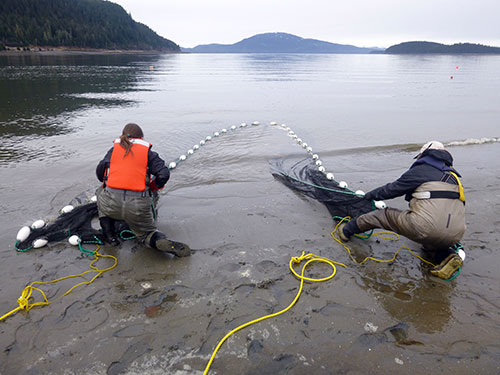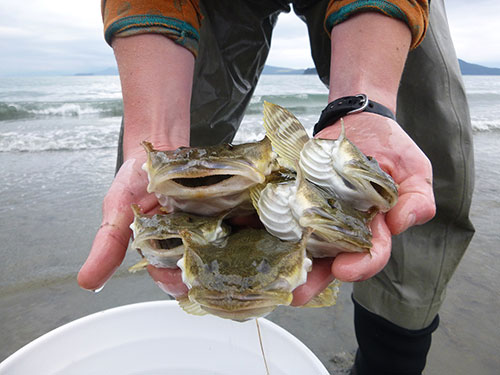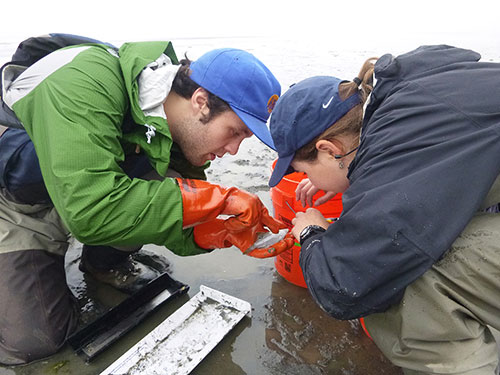
Glacier meltwater into Southeast Alaska estuaries influences fish dietsBy LAUREN FRISCH
December 02, 2015
Estuaries are coastal water bodies that contain both saltwater from the ocean and freshwater from rivers or streams. The rivers and streams bring a variety of aquatic species to the coast. Southeast Alaska estuaries also get freshwater from glacier melt, which can introduce terrestrial species to the ecosystem. Currently, about 30 percent of the freshwater flowing into the Gulf of Alaska comes from glacier melt.
Emily Whitney and Doug Duncan pull in a seine net.
The study will reveal some of the links between glacier and estuary environments in Southeast Alaska. Understanding the effect of glacier melt on the whole estuary ecosystem is important because 95% of the glaciers in Southeast Alaska are thinning or retreating. As the glaciers continue to melt, this understanding will help researchers evaluate how estuary habitat and community composition are likely to change. Approximately 70,000 people in Southeast Alaska rely on estuaries and nearshore marine ecosystems for food, recreation, and economic support. Changes in these nearshore species impact not only Southeast Alaska marine ecosystems, but also the communities that rely on them. Glacier melt affects species that have low tolerance for changes in salinity or temperature, such as kelp, and the silt carried into estuaries blocks light, which makes it harder for algae to photosynthesize. But glacier runoff also delivers carbon and other nutrients downstream that could increase productivity in estuaries.
A handful of Pacific staghorn sculpin at one of the research sites.
Beaudreau and Whitney are studying diets of juvenile coho salmon, Dolly Varden, starry flounder and Pacific staghorn sculpin, which are abundant in Southeast Alaska estuaries with and without the influence of glacier meltwater. In addition, starry flounder and staghorn sculpin are in the middle of the food web—they are an important food source for predators like halibut, bears, otters and eagles, and they shape the environment by preying on smaller fish and insects. The researchers collected fish samples at estuaries near Juneau with varying levels of influence from glacier meltwater. Cowee Creek estuary is 13 percent glaciated (covered by glaciers). In contrast, the Eagle River estuary is 48 percent glaciated, and the Mendenhall River estuary is 63 percent glaciated. Samples were collected by seining along beaches in the estuaries near the mouths of the creeks and rivers from April to September 2014. The researchers identified all fish from the seine nets, and now they are looking at the stomach contents of a sample of fish to get a snapshot of the fish diets in each of the estuaries. They also plan to analyze carbon and nitrogen isotopes in fish muscles to get a long-term look at the food different fish have been eating. Beaudreau and Whitney have begun looking at trends in staghorn sculpin diets. “Staghorn sculpins are small fish with big mouths, and pretty much eat whatever fits inside their mouth,” Beaudreau said, making them a good indicator for prey species living in each estuary. So far, the researchers have found that staghorn sculpin have been eating both aquatic and terrestrial insects as well as a range of marine invertebrates and fish. This suggests that rivers and glacier melt play an important role in affecting the availability of prey for these fish.
Doug Duncan and Emily Whitney work at one of the sampling sites.
The initial results suggest that the differences in diet over the season are greater than differences in diet between the various estuaries. The freshwater-tolerant species represent only a fraction of the total diet. More variation is occurring based on when species are available throughout the season. The data collected during this study will help establish a baseline understanding of how glacier melt can influence food sources for estuary fish. As glaciers continue to recede in Southeast Alaska, this understanding will help scientists and communities better understand how to sustainably manage coastal ecosystems and resources.
This article is provided as a public service by Alaska Sea Grant, the statewide marine research, education, and outreach program and is a partnership between the University of Alaska Fairbanks and the National Atmospheric and Oceanographic Administration.
|
||


